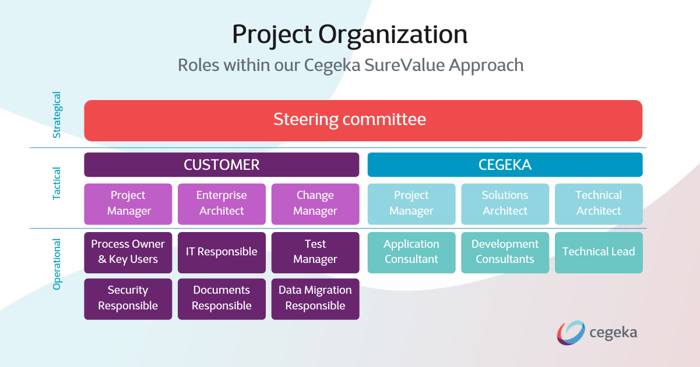In this third article of Together in Tech, you’ll find an overview of all the ERP roles and their responsibilities and insights in how many much time they should free up in which phase. Also, we have added a calculator tool to help you estimate the people and hours you will need + examples on how and when to assemble your crew. Sounds good right? Continue reading below.
Which roles do you need for your ERP project?
Before you start your ERP project, we would like to make sure you’re fully equipped to make it a resounding success. For this success, a strong team is an absolute must. So who do you need in your ERP squad? We’ve listed some of the most important roles – with some sidenotes:
- For small projects one person can take on multiple roles – but for large ERP projects, that’s usually not the best idea.
- Some of these roles might not apply to your organization, or have a slightly different interpretation of the job. That’s perfectly fine—tailor them to fit your unique needs and approach!
- Maybe your ERP plans require an extra role that’s not defined here: that’s cool too – no two ERP projects are the same.
Not sure how much time your ERP team will need? With this handy Excel tool, you’ll get an estimate of the hours each person will need to dedicate to your ERP project.
The coordinators
The project manager takes the lead in planning. This person needs a clear view on the ERP project and enough buy-in from the company to keep everything – and everyone – in check. With a minimum of 3 days per week, they’ll need to dedicate quite a bit of time to your ERP plans. You can opt for an external PM, but beware: they often don’t have the deep knowledge of your organization and/or peer recognition required to lead with confidence.
The business architect and project manager roles are often combined. Where the PM keeps a tight grip on planning, the business architect knows the business requirements inside-out. Basically, they’re the in-house counterpart to your ERP partner’s solution architect. The larger your ERP project, the bigger the chance that the PM and business architect will need to be two separate people. Though they will need to collaborate closely to ensure everything runs smoothly, of course.
ERP projects also bring major changes for your organization. To facilitate these changes and help your employees or colleagues adjust smoothly, a change manager can be very helpful. Contrary to most other roles in an ERP project, this is often an external expert, as change communication and management are a specific skill that most organizations don’t have on the payroll.
The crew
Process owners are key figures within your organization: they are responsible for specific end-to-end business processes. For their specific process, they will know what is required and if any changes will need to be made along the way.
Finally, we have the key users: the people on the floor who will need to work with the new ERP system. They are the ones who will be testing things out in the field, help set everything up and report to the process owners what works and what doesn’t.
The IT crowd
Besides the above tasks – which are already extensive – you’ll also need some boots on the ground, either in-house or with your ERP partner, to cover the IT groundwork. The main jobs at hand:
- Data migration: analyze the existing data in the source systems, collect them and clean them up and migrate them to the new ERP system.
- Document design: designing the right lay-out for all your important documents, from invoices to order confirmations, packing slips and more. And after designing, uploading and implementing them in the new ERP system.
- Application management: both during the ERP implementation and after the go-live, you’ll need someone who manages your applications – troubleshooting, helping other key users and installing patches, for example. Often, this system administrator will also be responsible for security, creating new users and so on.

When should I assemble my ERP team?
You should invite people and get them excited for an ERP project. So ideally, your ERP dream team has been asked to join the efforts before it kicks off. At the very least, you should involve them at the start of the project, when you’re determining your business processes and analyzing your requirements.
This way, their thoughts and concerns are included in the ERP project, and they were involved in the decisions made. In turn, that makes the change process easier: understanding why certain choices were made, goes a long way to accepting them.
"About 130 DELA employees use the system: advisors, undertakers, zone managers...all people who work in the funeral industry and aren't necessarily very tech-savvy. Perhaps the biggest challenge of the project was to get everyone on board."
Guy Moens
IT Delivery Manager at DELA
How to free up work hours for your ERP project
ERP projects are intense – particularly because more often than not, they come on top of your day job. Freeing up enough space can be a challenge. Unfortunately, there’s no one-size-fits-all answer. But fortunately, we do have some suggestions to keep everyone engaged and motivated:
- get some extra colleagues on the ERP project: this is mainly for process owners and key users.
- find some temporary (interim) partners that can take over some more basic tasks, freeing up some breathing room for your ERP team
- opt for outsourcing where possible, preferably with your ERP partner – up to a certain point, they can often accelerate faster than the in-house team
- add one or two business analysts to the party to support your process owners and key users
- prioritize – based on your business goals and processes – and work in phases
35%*
of failed ERP projects are due to underestimating the workload
*Source:: slide Gartner, Panorama Consulting Group, Technology Evaluation Center
Let's work together in Tech?
Cegeka and Microsoft Dynamics 365: it's a perfect match! Get in touch and let’s discuss your ERP project together.
Together in Tech: there’s no I in ERP
To successfully start and finish an ERP project, we need to work on it together. Join us and our customers as we zoom in on all things ERP – from the perspective of true partnership. Check out all the Together in Tech articles here.




